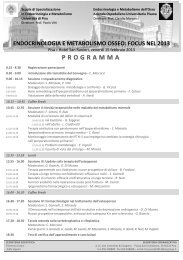Create successful ePaper yourself
Turn your PDF publications into a flip-book with our unique Google optimized e-Paper software.
Claudia Luchetti<br />
καὶ λέγεται µέν γέ τις, ἔφη, λόγος, ὡς οἳ ἂν τὸ ἥµισυ ἑαυτῶν ζητῶσιν, οὗτοι ἐρῶσιν· ὁ δ' ἐµὸς λόγος<br />
οὔτε ἡµίσεός φησιν εἶναι τὸν ἔρωτα οὔτε ὅλου, ἐὰν µὴ τυγχάνῃ γέ που, ὦ ἑταῖρε, ἀγαθὸν ὄν…<br />
Symposion, 205d10-e3<br />
In Socrates speech, Diotima answers to the proposal of a definition of Eros given by Aristophanes,<br />
τοῦ ὅλου οὖν τῇ ἐπιθυµίᾳ καὶ διώξει ἔρως ὄνοµα (192e10-193a1), with an extremely clear alternative:<br />
Love is not primarily Love of the One, a notion that in its polisemy can express both the unity of the<br />
part and the unity of the whole, but Love of the Good as such. Therefore, the longing for the One,<br />
dominant in Aristophanes' speech, has to be corrected and reread as a consequence of its being Good,<br />
and not vice versa.<br />
An extraordinary evidence of the supremacy of ἀγαθόν on ἕν can be deduced from the<br />
characteristics of the erotic path, whose departing point is the more adequate definition of Eros as<br />
Love of the Good and of its eternal possession, that is to say, of Immortality (204d1 ff.), culminating<br />
in the epiphany of Beauty itself.<br />
The dialectical methodology employed within the description of the psychic ascent that<br />
proceeds through the diverse degrees of the erotic mysteries, shows some particularities that require to<br />
be at least mentioned: Plato accustomed us, from the Euthyphron (6c-e), through the Republic (book<br />
V 476b-d, 479c-e) and the Phaedrus (249b-c, 266b-c), until the Philebus (12b-15c), just to mention<br />
few examples, to behold as the first operation of Dialectics (see Soph. 253c-e) the passage,<br />
paraphrasing the Phaedrus, ‘from a multiplicity approached through the senses to a Unity articulated<br />
with/and apprehensible through reasonment’.<br />
In the <strong>Symposium</strong> Plato challenges us to grasp a much more complex use of συναγωγή and its<br />
variations, from a double point of view:<br />
1) First of all, we have an evident and structural interaction between Unity and Multiplicity:<br />
without needing to arise any doubt about the clear pyramidal and hierarchic organization of the<br />
various degrees of manifestation of Beauty, one can observe that the starting point of this elevation<br />
are not τὰ πολλὰ καλὰ, how one may expect, but a single perceivable object regarded as beautiful<br />
(210a4-8). To avoid the possible mistake of identifying a merely apparent unity of this kind with the<br />
true ‘One’, which is the τέλος of the whole path, the συναγωγή seems to be applied, so to say, upside<br />
down, introducing only in a second phase a phenomenal multiplicity, and this in order to allow the<br />
initiate to recognize, by contrast, an ontologically higher level Unity which no longer belongs to the<br />
bodily sphere. The most immediate consequence of the reiterated use of this method, is the production<br />
of those possible combinations of Unity and Multiplicity, which punctually anticipate the description,<br />
made explicit in the Sophist, of all the operations of the διαλεκτικὴ ἐπιστήµη (see 253d1-253e2). It<br />
follows further, that once the level of Beauty of a single ψυχή and of the many ψυχαί has been<br />
reached, the erotic-dialectical dynamic will keep taking place only within the intelligible realm<br />
(210b6 ff.).<br />
2) Secondly, one can notice the presence, nearly completely hidden, of the well known<br />
dialectical counterpart of this way of forthcoming through more and more articulated and deep levels<br />
of Unification: the way of διαίρεσις. That reduction to Unity, which seemed to be developed upside<br />
down, working as a mediator between a lower range unity and the infinite multiplicity that could<br />
follow it immediately, preventing, exactly as in the former case of the erotic fixation on the apparent<br />
unity of departure, from recognizing traces of Identity and Unity (ἕν τε καὶ ταὐτόν, 210b3), which are<br />
indispensable to reach the following ontological layer, is in reality the dichotomic method: ἀπὸ ἑνὸς<br />
ἐπὶ δύο καὶ ἐπὶ δυοῖν ἐπὶ πάντα τὰ καλὰ σώµατα, 211c3-4. It is therefore legitimate to conclude that<br />
συναγωγή and διαίρεσις, even if they do not occur as technical terms, are constantly acting on the<br />
background of the erotic ascent in a synergic and indissoluble way.<br />
Why is it possible, even moving from these few premises, to claim both that Diotima’s<br />
perspective is agathological, and to establish its supremacy on Aristophanes henological position,<br />
carried out in his speech?<br />
Because the path of mysteric initiation that leads to the contemplation of Beauty, goes through<br />
a process of expansion from the One to the Many, that evidently places some Multiplicities (like the<br />
one of all bodies or the one of the Souls) on a higher level than that of some Unities (respectively, of<br />
the single body or of the single Soul). By proceeding with this generalization, these Multiplicities are<br />
further synthesized in higher Unities, until the arrival at the τέλος. Therefore, the synthetic Unities<br />
contemplated ‘from time to time’, reveal themselves as complex Beings, that is, as Totalities or<br />
Wholes, ὅλοι.<br />
From an ontological point of view then, the Idea of Beauty-Good, even though it is µονοειδές<br />
297




